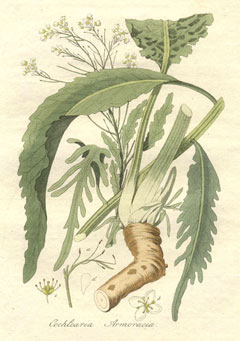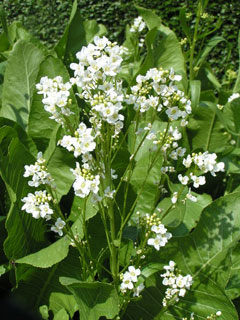 |
|
http://commons.wikimedia.org/wiki/File:Armoracia_rusticanaAHA.jpg |
 |
| http://commons.wikimedia.org/wiki/User:Pethan |
Translate this page:
Summary
Bloom Color: White.
Main Bloom Time: Early summer, Late spring, Mid spring.
Physical Characteristics

 Armoracia rusticana is a PERENNIAL growing to 0.7 m (2ft 4in) by 0.8 m (2ft 7in) at a fast rate.
Armoracia rusticana is a PERENNIAL growing to 0.7 m (2ft 4in) by 0.8 m (2ft 7in) at a fast rate.
See above for USDA hardiness. It is hardy to UK zone 5 and is not frost tender. It is in flower from May to June. The species is hermaphrodite (has both male and female organs) and is pollinated by Bees, flies, beetles. The plant is self-fertile.
Suitable for: light (sandy), medium (loamy) and heavy (clay) soils and prefers well-drained soil. Suitable pH: mildly acid, neutral and basic (mildly alkaline) soils and can grow in very alkaline soils.
It can grow in semi-shade (light woodland) or no shade. It prefers moist soil.
UK Hardiness Map
US Hardiness Map
Synonyms
Armoracia armoracia. Armoracia rustica. Cardamine armoracia. Rorippa armoracia.
Plant Habitats
Woodland Garden Sunny Edge; Dappled Shade;
Edible Uses
Edible Parts: Leaves Root Seed
Edible Uses: Condiment
Young root - raw or cooked. The grated root is used to make the condiment 'Horseradish sauce'[2, 9, 13, 14, 27, 33, 34, 52], this has a hot mustard-like flavour[100]. The sauce is best used uncooked or gently warmed, heating it will destroy the volatile oils that are responsible for its pungency[238]. It is said that in Germany the roots are sliced and cooked like parsnips[183] - rather them than me![K]. The root is a rich source of sulphur[201]. Fresh roots contain the glycoside sinigrin - this is decomposed in the presence of water by the enzyme myrosin, producing mustard oil which gives the root its hot flavour[268]. The fleshy roots can be up to 60cm long and 5cm thick[268]. The plant is fully hardy and can be left in the ground all winter to be harvested as required[4]. Alternatively, the roots can be harvested in early winter and stored for later use, they will retain their juicy state for some time if stored in dry sand[4]. Young leaves - raw or cooked[2, 9, 14, 177]. A very strong flavour, though nice when added in small quantities to the salad bowl[183, K]. A pleasant mild flavour according to another report[238]. Seeds - sprouted and eaten in salads[183].
References More on Edible Uses
Medicinal Uses
Plants For A Future can not take any responsibility for any adverse effects from the use of plants. Always seek advice from a professional before using a plant medicinally.
Antibacterial Antirheumatic Antiseptic Aperient Digestive Diuretic Expectorant Rubefacient
Stimulant Urinary
Horseradish is a very pungent stimulant herb that controls bacterial infections and can be used both internally and externally[238]. The plant is a powerful stimulant, whether used internally as a spur for the digestive system or externally as a rubefacient[4]. It should not be used internally by people with stomach ulcers or thyroid problems[238]. The roots are antiseptic, aperient, digestive, diuretic, expectorant, rubefacient and stimulant[4, 13, 14, 165, 171, 222]. They should be used in their fresh state[4]. An infusion is used in the treatment of colds, fevers and flu and is of value in the treatment of respiratory and urinary tract infections[254]. A sandwich of the freshly grated root is a traditional remedy for hay fever[254]. A tea made from the root is weakly diuretic, antiseptic and expectorant[222]. The plant is antibiotic against gram-negative and gram-positive bacteria and also pathogenic fungi[222, 240]. It is experimentally antitumor[222]. Externally, a poultice made from the roots is used to treat pleurisy, arthritis and infected wounds[238]. It will also relieve the pain of chilblains[244]. Some caution should be employed, however, because it can cause blistering[254]. The German Commission E Monographs, a therapeutic guide to herbal medicine, approve Armoracia rusticana for internal & external use in catarrhs of the respiratory tract, internally as supportive therapy for urinary tract infections, externally for the hyperaemic treatment of minor muscles aches (see [302] for critics of commission E).
References More on Medicinal Uses
The Bookshop: Edible Plant Books
Our Latest books on Perennial Plants For Food Forests and Permaculture Gardens in paperback or digital formats.

Edible Tropical Plants
Food Forest Plants for Hotter Conditions: 250+ Plants For Tropical Food Forests & Permaculture Gardens.
More

Edible Temperate Plants
Plants for Your Food Forest: 500 Plants for Temperate Food Forests & Permaculture Gardens.
More

More Books
PFAF have eight books available in paperback and digital formats. Browse the shop for more information.
Shop Now
Other Uses
Fungicide Repellent
Horseradish tea is effective against brown rot of apples and other fungicidal diseases[18, 201]. The growing plant deters potato eelworm[14].
Special Uses
Food Forest
References More on Other Uses
Cultivation details
Landscape Uses:Massing, Seashore. A very easily grown plant, horseradish prefers a good deep moist well-drained soil and a sunny position[16, 27, 33, 200]. Plants require a good soil if they are to produce good roots[4], though once established they are very tolerant of neglect and will continue to produce a crop for many years[264, K]. Plants do not thrive if they are in the shade of trees[264]. Excess nitrogen causes heavy top growth and forking of the roots[200]. Prefers a wet clay soil according to one report[14], whilst another says that it will not grow in wet clay[16]. Tolerates a pH in the range 5.8 to 8.3. Horseradish has long been cultivated for its root which is used as a food flavouring and medicinally, there are some named varieties[4, 17, 61, 183]. If the roots are given some protection they will produce fresh young leaves for the salad bowl all through the winter. Digging up some roots and putting them into a greenhouse for the winter is the easiest method. If the young shoots are blanched they will produce white, tender, sweet leaves[183]. A very invasive plant[33], it is considered to be a pernicious weed in some areas[200]. Even quite small sections of root will regrow if they are left in the soil[4]. The plant has yet to prove invasive on our Cornwall trial grounds, though it has survived and even prospered in a very overgrown site[K]. The forms of this plant grown in gardens are almost sterile and seldom produce good seed[264]. This is a good companion plant for potatoes since it is said to deter potato eelworm[14, 18, 201] and the Colorado beetle[238]. One plant at each corner of the potato patch is quite sufficient[201]. When grown under apple trees it is said to prevent brown rot, powdery mildew and other fungal diseases[201].Special Features:Fragrant foliage, Not North American native, Invasive, Naturalizing, Fragrant flowers. The plant is heat tolerant in zones 12 through 1. (Plant Hardiness Zones show how well plants withstand cold winter temperatures.
Plant Heat Zones show when plants would start suffering from the heat.
The Plant Heat Zone map is based on the number of "heat days" experienced in a given area where the temperature climbs to over 86 degrees F (30°C).
At this temperature, many plants begin to suffer physiological damage. Heat Zones range from 1 (no heat days) to 12 (210 or more heat days).
For example Heat Zone. 11-1 indicates that the plant is heat tolerant in zones 11 through 1.) For polyculture design as well as the above-ground architecture (form - tree, shrub etc. and size shown above) information on the habit and root pattern is also useful and given here if available. The plant growth habit is a runner spreading indefinitely by rhizomes or stolons [1-2]. The root pattern is a tap root similar to a carrot going directly down [1-2].
References Carbon Farming Information and Carbon Sequestration Information
Temperature Converter
Type a value in the Celsius field to convert the value to Fahrenheit:
Fahrenheit:
The PFAF Bookshop
Plants For A Future have a number of books available in paperback and digital form. Book titles include Edible Plants, Edible Perennials, Edible Trees,Edible Shrubs, Woodland Gardening, and Temperate Food Forest Plants. Our new book is Food Forest Plants For Hotter Conditions (Tropical and Sub-Tropical).
Shop Now
Plant Propagation
Seed - this is seldom produced on plants in cultivation[200]. If seed is obtained then it is best sown in situ during the spring[238]. Division is very easy and can be carried out at almost any time of the year, though it is probably best in spring[33]. It s best to use sections of root about 20cm long, which can be planted out into their permanent positions in February or March, though even very small bits of root will grow away[4, 264]. Division should be carried out at least once every three years or the crop will deteriorate[4].
Other Names
If available other names are mentioned here
Native Range
EUROPE: Moldova,
Weed Potential
Right plant wrong place. We are currently updating this section.
Please note that a plant may be invasive in one area but may not in your area so it's worth checking.
Conservation Status
IUCN Red List of Threatened Plants Status :

Growth: S = slow M = medium F = fast. Soil: L = light (sandy) M = medium H = heavy (clay). pH: A = acid N = neutral B = basic (alkaline). Shade: F = full shade S = semi-shade N = no shade. Moisture: D = dry M = Moist We = wet Wa = water.
Now available:
Food Forest Plants for Mediterranean Conditions
350+ Perennial Plants For Mediterranean and Drier Food Forests and Permaculture Gardens.
[Paperback and eBook]
This is the third in Plants For A Future's series of plant guides for food forests tailored to
specific climate zones. Following volumes on temperate and tropical ecosystems, this book focuses
on species suited to Mediterranean conditions—regions with hot, dry summers and cool, wet winters,
often facing the added challenge of climate change.
Read More
Expert comment
Author
Gaertn.,C.A.Mey.&Scherb.
Botanical References
200
Links / References
For a list of references used on this page please go here
Readers comment